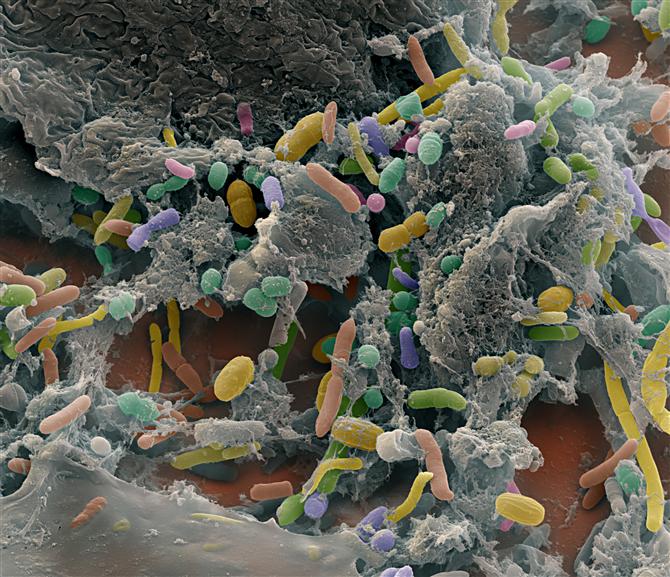

Microbes and humans have a relationship, particularly in the gut. Some can be mutual leading to better health while others can be pathogenic. To gain the most benefit from these microbial symbioses, researchers have attempted to learn which bacteria interact with one another and more importantly, which conditions are best to enable their efforts.
Unfortunately, this is not an easy task. The intestines are about six to seven metres in length and may have a variety of different environmental conditions. Some areas are acidic, others are alkaline. The levels of nutrients differ. Oxygen also plays a role as the small intestines usually are filled with oxygen while the colon is predominantly anaerobic. Depending on the amount of this element, various bacteria may choose to work together or simply fend for themselves.
Figuring out the best combinations is not an easy task and is essentially impossible to determine within the human body. Yet, researchers have worked to develop lab-based systems to mimic the workings of the gut and how microbes interact within the tracts. This allows scientists to gain an appreciation of what happens inside the intestines. It also offers an opportunity to change the conditions to determine which effects can lead to symbiosis. The models also permit the introduction of various microbial species to determine if they have any impact on the population and our health.
One of the most intriguing models happens to have no biological components. Instead, the entire intestinal system is developed using computers. The various components of metabolism are compiled from various other sources, including the scientific literature and the plethora of databases on human biological function. Once they are assembled, the entire system is called a metabolic reconstruction.
Once a reconstruction has been developed, researchers can then play with various factors to determine how the system will respond. This can include changes in diet, the addition of pharmaceutical agents, and the addition of microbial entities. In the latter case, the focus has been helpful to understand pathogens such as tuberculosis and infectious bacteria associated with cystic fibrosis.
Last week a team of researchers from Luxembourg developed an entirely new system to look at how bacteria interact. Instead of a biological model, they chose a synthetic one in the form of a computer program. Their results revealed how a small collection of species can work with each other to make the intestinal environment healthy.
The first stage of the experiment involved designing a computerized intestinal tract. They had already accomplished through an examination of the metabolic processes that occur within intestinal cells. All they needed to do was add in the bacterial information and investigate what might happen.
The team introduced 11 different bacterial species in pairs. They could then determine the mechanisms of symbiosis, or in the opposite way, antagonism. Their selection consisted of species known to consistently be in the gastrointestinal tract. Some were harmless bacteria, known as commensals. Others were probiotic in nature. Then there were the pathogens. All three types can be found in each of us and so the group felt this could be a good representation of what happens in all of us.
The results were to some extent expected. Commensals were givers of benefit to other species and eventually to the human intestines. The probiotics were community-focused such that they worked with other probiotic species to thrive. As for the pathogens, they tried to compete against the other species in order to gain a hold and begin to cause trouble. But while this came as no surprise, there were other fascinating revelations waiting to be found.
The first revealed how the body toys with microbes to induce competition between species. It did this by providing food for certain bacteria but not for others. This dangling carrot concept apparently allowed certain species, primarily pathogens, to lose out. As for the probiotic species, they were more than happy to receive the food and grow.
The other revelation involved just how to form a good mutual environment. The researchers simply needed to deplete one particular resource: oxygen. For some reason, having less oxygen led bacteria to seek out one another and form mutual partnerships. This was primarily to prevent starvation by some species as they cannot live effectively without oxygen. As for which symbioses occurred, once again, the separation was along ecological lines. Probiotics and commensals had great friendships; the pathogens tended to lose out.
Although this may seem odd at first, the researchers realized this was a social occurrence not unlike what happens in the human world. When humans are alone with a rich amount of food, water, and shelter, we tend to do well without interactions with others. But take away one of those factors and suddenly mutualism occurs. People tend to help others by offering something to improve the quality of life. This essentially is the case at the microbial level. When one of the most important elements goes missing, the bacteria tend to group together and form alliances to improve the chances for survival.
The overall results reveal a potential path for mutualism at the microbial level. Granted, this was a computerized model so the outcomes have to be accepted with limitations. Yet, the findings do offer some hope in determining how to investigate microbial interactions in the context of improving human health. Whether through the promotion of commensal bacteria, the introduction of probiotics or through treatment to combat pathogens, this study offers some perspective on the ecological environment of the intestines as well as the complexity – and to some extent simplicity – of what happens on our insides.
